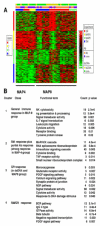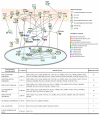Gene expression profiles in a rabbit model of systemic lupus erythematosus autoantibody production
- PMID: 20817871
- PMCID: PMC2949067
- DOI: 10.4049/jimmunol.1001254
Gene expression profiles in a rabbit model of systemic lupus erythematosus autoantibody production
Abstract
We previously reported the establishment of a rabbit (Oryctolagus cuniculus) model in which peptide immunization led to production of lupus-like autoantibodies including anti-Sm, -RNP, -SS-A, -SS-B, and -dsDNA characteristic of those produced in systemic lupus erythematosus (SLE) patients. Some neurologic symptoms in the form of seizures and nystagmus were observed. The animals used in the previous and in the current study were from a National Institute of Allergy and Infectious Diseases colony of rabbits that were pedigreed, Ig-allotype defined, but not inbred. Their genetic heterogeneity may correspond to that found among patients of a given ethnicity. We extended the information about this rabbit model by microarray-based expression profiling. We first demonstrated that human expression arrays could be used with rabbit RNA to yield information on molecular pathways. We then designed a study evaluating gene expression profiles in eight groups of control and treated rabbits (47 rabbits in total). Genes significantly upregulated in treated rabbits were associated with NK cytotoxicity, Ag presentation, leukocyte migration, cytokine activity, protein kinases, RNA spliceosomal ribonucleoproteins, intracellular signaling cascades, and glutamate receptor activity. These results link increased immune activation with upregulation of components associated with neurologic and anti-RNP responses, demonstrating the utility of the rabbit model to uncover biological pathways related to SLE-induced clinical symptoms, including neuropsychiatric lupus. Our finding of distinct gene expression patterns in rabbits that made anti-dsDNA compared with those that only made other anti-nuclear Abs should be further investigated in subsets of SLE patients with different autoantibody profiles.
Figures






Similar articles
-
Genetic contributions to the autoantibody profile in a rabbit model of Systemic Lupus Erythematosus (SLE).Vet Immunol Immunopathol. 2008 Oct 15;125(3-4):251-67. doi: 10.1016/j.vetimm.2008.05.020. Epub 2008 Jul 3. Vet Immunol Immunopathol. 2008. PMID: 18602165 Free PMC article.
-
Investigations of a rabbit (Oryctolagus cuniculus) model of systemic lupus erythematosus (SLE), BAFF and its receptors.PLoS One. 2009 Dec 30;4(12):e8494. doi: 10.1371/journal.pone.0008494. PLoS One. 2009. PMID: 20041151 Free PMC article.
-
Models of systemic lupus erythematosus: development of autoimmunity following peptide immunizations of noninbred pedigreed rabbits.J Immunol. 2006 Jan 1;176(1):660-7. doi: 10.4049/jimmunol.176.1.660. J Immunol. 2006. PMID: 16365462
-
Autoantigen Microarray for High-throughput Autoantibody Profiling in Systemic Lupus Erythematosus.Genomics Proteomics Bioinformatics. 2015 Aug;13(4):210-8. doi: 10.1016/j.gpb.2015.09.001. Epub 2015 Sep 28. Genomics Proteomics Bioinformatics. 2015. PMID: 26415621 Free PMC article. Review.
-
Mechanisms of autoantibody diversification to SLE-related autoantigens.Ann N Y Acad Sci. 2003 Apr;987:91-8. doi: 10.1111/j.1749-6632.2003.tb06036.x. Ann N Y Acad Sci. 2003. PMID: 12727627 Review.
Cited by
-
Rabbit models of human diseases for diagnostics and therapeutics development.Dev Comp Immunol. 2019 Mar;92:99-104. doi: 10.1016/j.dci.2018.10.003. Epub 2018 Oct 16. Dev Comp Immunol. 2019. PMID: 30339876 Free PMC article. Review.
-
Distinct autoantibody profiles in systemic lupus erythematosus patients are selectively associated with TLR7 and TLR9 upregulation.J Clin Immunol. 2013 Jul;33(5):954-64. doi: 10.1007/s10875-013-9887-0. Epub 2013 Apr 7. J Clin Immunol. 2013. PMID: 23564191
-
Impact of high predation risk on genome-wide hippocampal gene expression in snowshoe hares.Oecologia. 2014 Nov;176(3):613-24. doi: 10.1007/s00442-014-3053-0. Epub 2014 Sep 19. Oecologia. 2014. PMID: 25234370
-
Genome-wide immunity studies in the rabbit: transcriptome variations in peripheral blood mononuclear cells after in vitro stimulation by LPS or PMA-Ionomycin.BMC Genomics. 2015 Jan 23;16(1):26. doi: 10.1186/s12864-015-1218-9. BMC Genomics. 2015. PMID: 25613284 Free PMC article.
-
Differential microRNA profile and post-transcriptional regulation exist in systemic lupus erythematosus patients with distinct autoantibody specificities.J Clin Immunol. 2014 May;34(4):491-503. doi: 10.1007/s10875-014-0008-5. J Clin Immunol. 2014. PMID: 24659206
References
-
- Pan Y, Sawalha AH. Epigenetic regulation and the pathogenesis of systemic lupus erythematosus. Transl. Res. 2009;153:4–10. - PubMed
-
- Jönsen A, Bengtsson AA, Nived O, Truedsson L, Sturfelt G. Gene-environment interactions in the aetiology of systemic lupus erythematosus. Autoimmunity. 2007;40:613–617. - PubMed
-
- Cohen-Solal JF, Jeganathan V, Hill L, Kawabata D, Rodriguez-Pinto D, Grimaldi C, Diamond B. Hormonal regulation of B-cell function and systemic lupus erythematosus. Lupus. 2008;17:528–532. - PubMed
-
- Werth VP. Cutaneous lupus: insights into pathogenesis and disease classification. Bull. NYU Hosp. Jt. Dis. 2007;65:200–204. - PubMed
Publication types
MeSH terms
Substances
Grants and funding
LinkOut - more resources
Full Text Sources
Medical
Molecular Biology Databases
Research Materials

